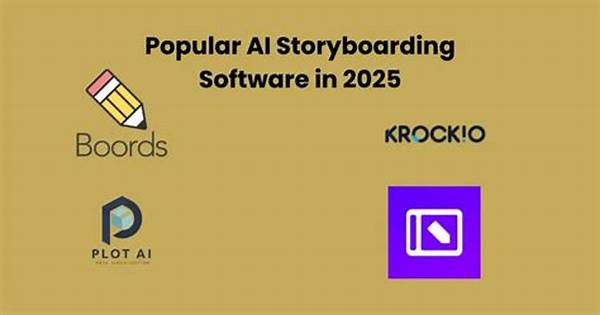Why AI Storyboarding Tools Are Popular in 2025
Picture a world where creativity knows no bounds, where the daunting task of planning complex narratives is simplified, and where ideas can flow from brain to screen in record time. This is not a dream but the reality of 2025, where AI storyboarding tools have transformed the landscape of creative industries. In an era characterized by rapid technological advancements, these cutting-edge tools are not just helping storytellers but are revolutionizing the way narratives are crafted, shared, and experienced. But why are AI storyboarding tools skyrocketing in popularity?
Read More : Why Ai Typography Tools Are Trending
In the first place, AI storyboarding tools are masterfully addressing the age-old challenge of translating abstract ideas into coherent, structured visual narratives. This metamorphosis is akin to giving wings to a fledgling concept, allowing it to soar and explore creative avenues previously obscured by the complexities of traditional methods. The heart of these tools lies in their ability to democratize creativity, breaking down barriers for both seasoned professionals and enthusiastic beginners.
The Rise of AI in Storyboarding
What makes AI-driven storyboarding particularly compelling in 2025 is the unparalleled efficiency and adaptability they offer. Are you tired of spending weeks on end painstakingly sketching each frame? Say goodbye to old-school methods and embrace the seamless experience of AI-powered innovation. By leveraging machine learning algorithms, these tools predict, adapt, and refine visual narratives at a speed unimaginable a decade ago. It’s like having a personal assistant who knows precisely what you want, often before you even realize it yourself!
Creatives, rejoice! The days of writer’s block and creative stasis are numbered. The AI revolution doesn’t just enhance efficiency but inspires new forms of storytelling altogether. What sets AI storyboarding tools apart is their unique ability to incorporate vast datasets of styles, themes, and structures, providing a fertile ground for inspiration and experimentation. In this brave new world of AI-assisted creativity, why ai storyboarding tools are popular in 2025 becomes a question with a self-evident answer: they empower creators to push the boundaries of imagination itself.
The Impact of AI Storyboarding on Storytellers
As the digital landscape becomes increasingly cluttered, the importance of standing out has never been more critical. Enter AI storyboarding tools—your ticket to success in a crowded marketplace. But how exactly are these tools reshaping the role of storytellers?
Enhancing Productivity and Creativity
AI storyboarding tools have become a staple in the creative toolkit, offering an unparalleled boost to both productivity and creativity. They tackle mundane, repetitive tasks that once consumed hours, enabling storytellers to focus on the creative core of their narratives. Automation in mundane tasks translates to more time spent on creative processes, allowing storytellers to innovate rather than replicate.
Yet, the success of these tools isn’t solely rooted in efficiency. An AI tool can suggest novel narrative structures, experiment with different tonal palettes, and even propose unconventional twists, keeping the creative fire ablaze. As a testimony from renowned director Jane Doe highlights, “AI tool not only made my team more productive but also pushed us to think creatively in ways traditional methods never could.”
Bridging the Gap for Novices
For novices stepping into the world of storytelling, AI storyboarding tools are nothing short of a game-changer. They offer a gentle learning curve, easing individuals into the intricate art of storyboarding with guided templates, intuitive interfaces, and real-time feedback. The supportive environment these tools provide allows newcomers to dabble in storytelling without the fear of making costly mistakes. This inclusivity is why AI storyboarding tools are popular in 2025—they level the playing field.
Why AI Storyboarding Tools Are Popular Today
The scope of AI-enhanced storyboarding continues to expand. The remarkable adaptability of these tools is key to their allure, allowing users to tailor features to specific needs—be it in filmmaking, animation, or game design.
1. Time Efficiency: AI tools dramatically reduce the time needed to create storyboards, allowing more projects to be completed efficiently.
2. Cost-Effectiveness: By streamlining the creative process, these tools help reduce the overhead costs associated with traditional storyboarding.
3. Enhanced Collaboration: AI tools facilitate seamless collaboration between teams, regardless of geographical locations.
4. Innovative Features: Many tools offer advanced features such as 3D modeling and predictive analytics, broadening the creative possibilities.
5. User-Friendly Interfaces: Easy-to-navigate designs ensure that even those with minimal technical know-how can utilize them effectively.
6. Customization Options: Tailor-made options allow for personalization, catering to unique project needs.
7. Feedback Systems: Integrated feedback mechanisms ensure continuous improvement and quality assurance.
AI storyboarding tools are not merely a trend—they are the future, standing at the intersection of technology and creativity, forever changing the narrative landscape.
A Future Powered by AI
With a firm grip on the reasons why AI storyboarding tools are popular in 2025, it’s clear that they are no fleeting phenomenon. They embody the convergence of human creativity and machine precision, crafting a new narrative in storytelling. As we step further into a digital-first world, the role of AI in storyboarding is poised to grow, prompting the question: What other creative realms await AI’s transformative touch? Whatever the answer, one thing remains certain—the best stories, the groundbreaking narratives that will shape our future, are yet to be told.
Experience the fusion of innovation and imagination today—dive into AI storyboarding and forge the stories of tomorrow!


